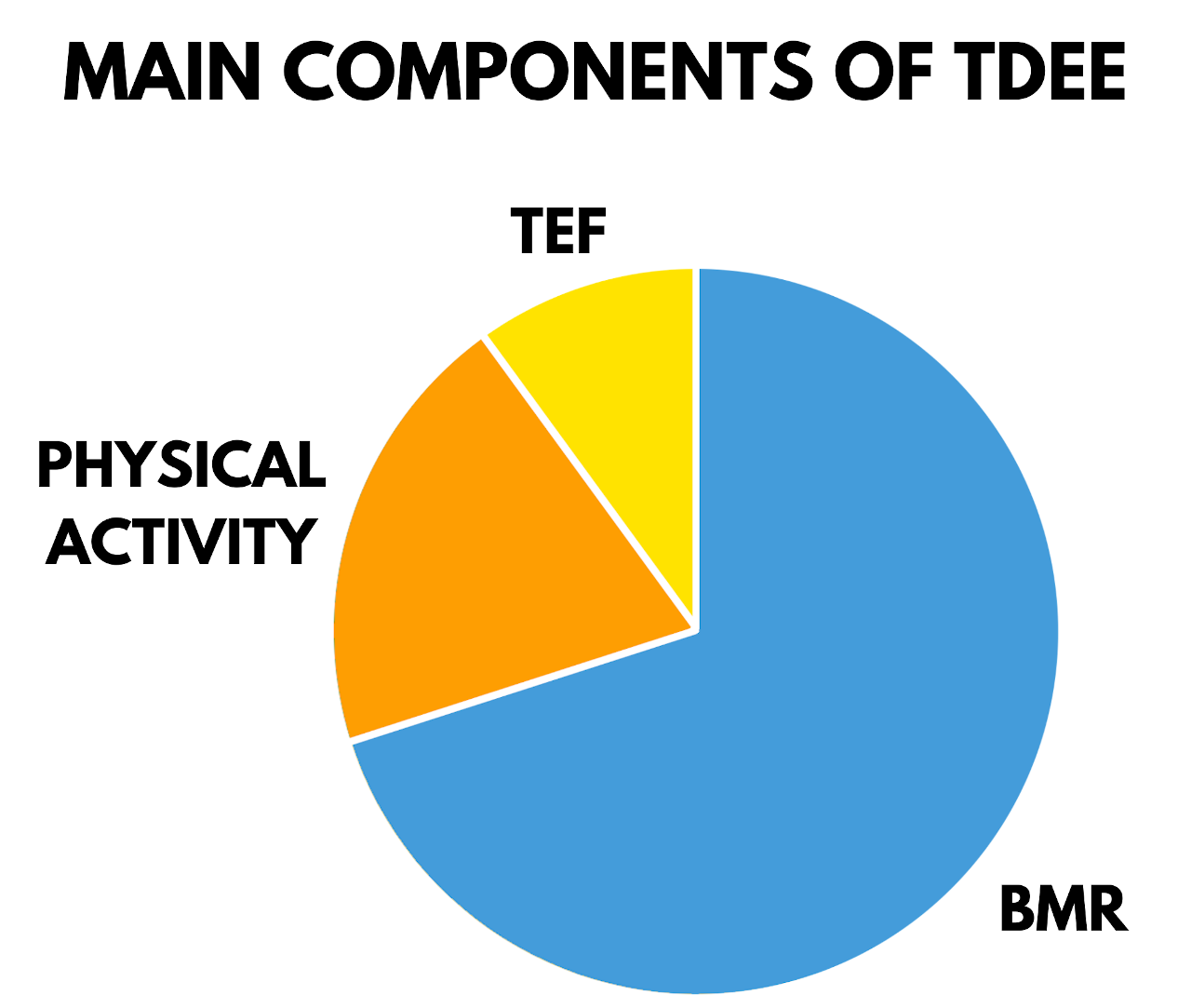TDEE Calculator – Find Your Total Daily Energy Expenditure
Calculate your total daily energy expenditure (TDEE) using your age, sex, height, weight, and activity level.
Calculated TDEE:
| Activity Level | Calories |
|---|---|
| Basal Metabolic Rate (BMR) | |
| little to no exercise | |
| light exercise 1-3 times per week | |
| moderate exercise 3-5 times per week | |
| heavy physical exercise 5-6 times per week | |
| heavy physical exercise 6-7 times per week |
Calculated BMI
On this page:
How to Calculate Total Daily Energy Expenditure
The amount of energy you burn each day is known as your total daily energy expenditure (TDEE). This consists of three main components:
- Your basal metabolic rate (BMR): This is your resting metabolism, which is the number of calories your body requires to function at complete rest and fuel vital organ functions, such as breathing or your heart beating.
- The thermic effect of food (TEF): Every time you eat, you also burn a small number of calories. The thermic effect of food is the energy that is expended during chewing, swallowing, digesting, absorbing, and storing food. This is influenced by the amount of calories you consume and the types of foods you eat. That is, the more you eat, the higher your TEF will be. It is typically no more than 10% of your BMR.
- The thermic effect of physical activity (TEPA): TEPA is the number of calories used during activity (e.g., exercise, physical activity) and non-exercise activity thermogenesis (NEAT). NEAT ranges from the energy expended during activities like walking around a store, sitting and typing, or doing yard work, and is also crucial for weight control.[2]

Since TEF is only a small portion of your daily calorie needs, a TDEE formula can be used to determine how many calories you burn each day by calculating your BMR and then multiplying this by a factor that is related to your average activity level.
The table below shows the activity factor for various levels of daily activity:[3]
| Level of Activity | Example | Activity Factor |
|---|---|---|
| Sedentary | Little to no exercise, such as a desk job with no additional physical activity | 1.2 |
| Lightly Active | Light exercise 1-2 days/week | 1.375 |
| Moderately Active | Moderate exercise 3-5 days/week | 1.55 |
| Very Active | Hard exercise 6-7 days/week | 1.725 |
| Extremely Active | Hard daily exercise and physical job or two times a day training | 1.9 |
TDEE Formula
To calculate your TDEE, you first need to determine your BMR. Different formulas have been created over the years to estimate BMR. The most commonly used are the Mifflin St. Jeor equation, the Harris-Benedict equation, and the Katch-McArdle equation.
Once you have calculated your BMR, you simply multiply this by your activity factor based on your average daily exertion from the table above.
TDEE = BMR × Activity Factor
Using TDEE to Calculate Calorie Needs
Calculating your Total Daily Energy Expenditure can be useful if you are trying to measure daily calories burned to aid in weight loss goals.
Although there are many factors that affect weight loss, an important one is the calories that you consume. In general, if you are trying to lose weight, you need to consume fewer calories than you burn. By measuring your TDEE, you will have a reasonable estimate of how many calories you should consume each day to maintain a calorie deficit.
Calories equal energy, and you exert energy through all physical activities, from intense exercise to sitting at your desk typing. This is your “calories out.” On the other side of the equation, the food and drinks that you consume count toward your “calories in.”
Your TDEE is the number of calories you burn each day. To determine how many calories you should eat, you need to first figure out your current weight goals.
By multiplying your BMR by your activity factor, you now have your TDEE, or an estimate of the total number of calories you should eat each day to maintain your current weight.
If you are trying to maintain your current weight, you can use that number as your daily calorie needs. On the other hand, if you want to lose weight, you first need to adjust this number based on weight goals.
Create a Calorie Deficit
One pound is approximately 3500 calories. So, if you maintained a calorie deficit of 500 calories a day, you could lose around one pound in a week. While this is not a perfect formula, it does help give you an idea of your calorie needs.
Numerous studies have found that when exercise is sufficient to produce an energy deficit of 500 to 1,000 calories per day, substantial weight loss can occur.[4]
Additional studies have shown that the weight loss resulting from similar calorie restrictions in moderately and severely obese females created similar results in body composition. Three sessions a week of moderate-intensity or high-intensity exercise were done. However, those participating in high-intensity exercise spent 40 percent less training time.[5]
If you cannot increase physical activity, decreasing calorie intake is also sufficient to lead to weight loss. Research has found that negative energy balance alone is responsible for weight reduction, whether this is by diet, exercise, or a combination of the two.[6]
Cut Calories Slowly To Maintain A Healthy Weight
You shouldn’t cut your calories too drastically if you are trying to lose weight. It is recommended to utilize small energy deficits to ensure a slow rate of weight loss. If you lose weight too rapidly, this can actually decrease your lean body mass and basal metabolic rate.
This will subsequently decrease your total daily energy expenditure.[7] An extreme calorie deficit will make weight loss more difficult, and make weight regain more likely if you increase calorie intake.[8]
Total Daily Energy Expenditure: A Tool For Calculating Calories Burned and Daily Needs
Measuring your total daily energy expenditure is a useful way to determine your daily calorie needs. This can help you maintain a healthy weight, or estimate your calorie deficit if you are trying to lose weight.
While these formulas are only guidelines, they can help you estimate your daily calorie needs based on your basal metabolic rate, level of activity, and current health goals.
References
- Centers for Disease Control and Prevention, About Adult BMI, https://www.cdc.gov/healthyweight/assessing/bmi/adult_bmi/index.html
- Levine, J. A., Non-exercise activity thermogenesis, Proceedings of the Nutrition Society, 2003, 62(3), 667-679. https://www.cambridge.org/core/journals/proceedings-of-the-nutrition-society/article/nonexercise-activity-thermogenesis/30B928A57E8A92BB87A89FA006DB5ACD
- Kelly, M., Resting Metabolic Rate: Best Ways to Measure It—And Raise It, Too, American Council on Exercise, https://www.acefitness.org/certifiednewsarticle/2882/resting-metabolic-rate-best-ways-to-measure-it-and-raise-it-too/
- Catenacci, V. A., & Wyatt, H. R., The role of physical activity in producing and maintaining weight loss, Nature Clinical Practice Endocrinology & Metabolism, 2007, 3(7), 518-529. https://www.nature.com/articles/ncpendmet0554
- Wewege, M., Van Den Berg, R. Ward, R.E., Keech, A., The effects of high-intensity interval training vs. moderate-intensity continuous training on body composition in overweight and obese adults: a systematic review and meta-analysis, Obesity Reviews, June 2017, 18(6), 635-646. https://pubmed.ncbi.nlm.nih.gov/28401638/
- Strasser, B., Spreitzer, A., & Haber, P., Fat loss depends on energy deficit only, independently of the method for weight loss, Annals of Nutrition and Metabolism, 2007, 51(5), 428-432. https://www.karger.com/Article/Abstract/111162
- Leibel, R. L., Rosenbaum, M., & Hirsch, J., Changes in energy expenditure resulting from altered body weight, The New England journal of medicine, 1995, 332(10), 621–628. https://pubmed.ncbi.nlm.nih.gov/7632212/
- Trexler, E. T., Smith-Ryan, A. E., & Norton, L. E., Metabolic adaptation to weight loss: implications for the athlete, Journal of the International Society of Sports Nutrition, 2014, 11(1), 1-7. https://jissn.biomedcentral.com/articles/10.1186/1550-2783-11-7



